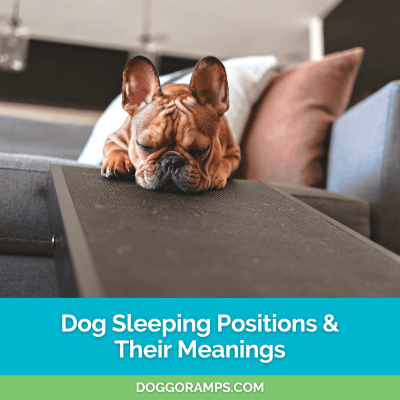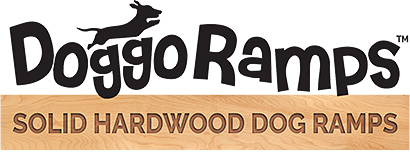Dog Sleeping Positions and Their Meanings

Want to learn more about your dog's mood? Try observing how and where they sleep.
Dogs are known for snoozing in some pretty unique and hilarious positions. While some may give us a good laugh, others may have us questioning how they’re possibly comfortable.
However, a dog’s sleeping position can also tell us a lot about their mood, feelings, and even their personality.
So read on to discover 9 of the most common dog sleeping positions, what they mean, and how you can create a better sleep environment for your dog.
1. Curled up like a Donut or Croissant
This position might just be one of the most common ones you’ll find your dog sleeping in, and it’s especially popular among smaller dogs.
When pups are snoozing in the “donut” or “croissant” position, they are curled up into a ball with their legs tucked in towards their body. This "configuration" often helps dogs conserve their body heat and stay warm. As well, many dogs choose to sleep this way as it helps cover up and protect their vital organs - making them feel more secure in their environment.

2. Sleeping on Their Side
This is one of the most relaxed sleeping positions your dog could choose. By exposing their belly while snoozing, dogs show that they are feeling very safe in their environment and are comfortable being vulnerable. This side sleeping position often shows that a dog is at ease and enjoying deep, restful sleep.

3. Napping on their Back
If you stumble upon your dog sleeping on their back with their paws in the air, this is a sign of absolute trust. While it’s always adorable to see, it also means that your dog is completely relaxed and feeling very comfortable with their surroundings since they're revealing their belly to the world.
This may be a preferred snoozing position for dogs on a hot day too as it helps them quickly cool off.
As dogs grow older and become less nimble, they may opt for other sleeping configurations. If that happens, it doesn’t mean they feel any less trust.

4. Sphinx or Lion’s Pose
In contrast to the sleeping positions described so far, the Sphinx or Lion’s pose is a popular choice for dogs that only want a quick rest and don’t plan on sleeping too deeply.
This position involves a dog crouching down on all fours and resting their head on their front paws - similar to the sphinx statue. It helps dogs to remain alert and vigilant as they rest and easily spring into action at any moment.

5. The Sploot Snooze
When a dog is sleeping in a sploot or “superman” configuration, they are snoozing on their belly with their hind legs sprawled out behind them. Their front legs will typically be sprawled out in front too. This sleeping position suggests that a dog is fairly tired but is also very relaxed. It also makes it easy for them to quickly get back up at a second’s notice - making this pose a popular choice for dogs seeking a mid-play break.
You may also find this sleeping position to be more common among puppies and younger dogs as it requires some flexibility and gives a good stretch.
And if you see your pup napping in sploot position on the floor, they may be trying to cool themselves down too!

Sophie the Dachshund from the Weenie Dog Pack takes a quick rest on her DoggoRamp before resuming play with her four-legged siblings.
6. Burrowing Under the Blanket
Does your dog like to nestle up under a blanket? Or maybe even under a pillow or your clothes? Dogs may choose to sleep like this for extra warmth and to feel more at ease as it can help dogs feel like they’re in a more protected environment.
Burrowing is particularly common among Dachshunds and Terriers as these dogs were bred to hunt smaller animals and follow them into tunnels and dens underground.

7. Sleeping by their Owners’ Feet
Dogs often want to sleep with their owners for extra comfort (few things compare to human furniture) and extra security too. Choosing to sleep with their “parent” not only shows the deep bond between the dog owner and their pup, but it reinforces it as well!
Once on the couch or bed, a dog may opt to snooze by their owner’s feet for several reasons. Some dogs with protective instincts choose this location as it’s the furthest point from their parent’s head. From this spot, they may feel that they can help out with keeping an eye on the surroundings their owner can’t.
If a person happens to move a lot in their sleep, a pup may decide to sleep by the feet so they can still be close to the person they love and benefit from their body heat but also reduce their chances of being jostled, pushed around, or possibly even rolled on as they rest.

8. Snoozing on their Owners
Many dogs feel safer and more comfortable when they are able to snooze next to their owners. But what if your dog prefers to sleep on you?
When a pup chooses to snooze on their owner, they may be trying to show their owner affection and provide them with extra comfort and security too. It shows a strong bond and deep level of trust between the owner and their dog.
However, it’s important to keep in mind that all dogs have different personalities and preferences. If your dog is not a “cuddler”, they may just be a pup who enjoys their independence and personal space. It doesn’t mean that you don’t share a strong bond with your dog.

9. Resting Back to Back
When a dog decides to sleep back-to-back with their owner, it shows that they trust that their human has their back… figuratively and literally!
They desire to feel close to their person and show affection but also feel safer knowing that there’s a set of eyes and ears facing a direction theirs aren’t.

Helping Your Dog Get a Good Night’s Sleep
Like humans, dogs need good quality sleep for their overall health and well-being. Proper rest can allow dogs to recover from physical activity, help with the proper functioning of their immune system, improve their mood, and support brain function too.
Fortunately, there are several things we can do as dog owners to help our dogs get a better night’s rest, such as:
1. Keeping Up with A Regular Sleep Schedule
Dogs thrive on structure and routine. Consistent schedules, including going to bed around the same time everyday, can help dogs learn what to expect in their day-to-day life. This can play a big role in helping them feel more confident and relaxed.
2. Making Sure Your Dog Has Access to a Quiet and Dark Environment
As mammals, dogs have circadian rhythms, also known as “internal clocks”, affected by light. With their incredible sense of hearing, dogs are a great deal more sensitive to sounds too.
Ensuring that your pup has a quiet and dark space to snooze can help reduce distractions and allow them to experience better quality sleep.
3. Providing Your Dog with a Comfortable and Supportive Place to Sleep
Dogs love comfort just as much as people and having a cozy place to rest can allow them to enjoy better sleep. A proper, supportive snooze spot can also be good for a dog’s joint health, especially for senior pups and dogs recovering from injuries.
And if your dog’s designated sleeping location happens to be your couch or bed, a dog ramp can help make sure that they have a safe and easy means of accessing their favorite spots without interrupting your sleep as well!
Check out what this dog owner had to say about introducing her pup to a bed ramp:

Why Choose a Dog Ramp & The Best Indoor Ramps for Dogs
Whether your dog loves to spend their nights on the couch, your bed, or a different piece of furniture, dog ramps can help!While many dogs make jumping on and off furniture look easy, it’s actually quite a “high load” activity - meaning it’s something that puts a significant amount of strain on a dog's muscles and joints, especially when done on a daily basis over time.
Thankfully, training your dog to use a dog ramp as an alternative to jumping can provide them with a safer and more convenient way of getting to and from their preferred sleeping spots - and prevent you from being woken up in the middle of the night to deliver human elevator rides.
And here at DoggoRamps, we’ve created the safest and best dog ramps on the market.
Our ramps:
- Are made from strong and durable solid maple hardwood - the standard in true furniture quality
- Feature a unique rubbery anti-slip surface to provide exceptional traction
- Include adjustable height settings so that they can work with any couch or bed - including beds up to 35” tall (Large Bed Ramp) and 37” tall (Small Bed Ramp)
- Can be ordered with reversible and removable rails for extra safety - check out our NEW Couch Ramp with Safety Rails! (All bed ramps automatically come with rails)
All in all, if you feel that your dog would benefit from a dog ramp, introducing them to one that’s well made can play a big role in making sure that they have a ramp that they will actually use and enjoy!
 DoggoRamps are a hit among dogs of all ages and sizes.
DoggoRamps are a hit among dogs of all ages and sizes.
Your pup’s sleeping positions aren’t just adorable - they have a lot to say about their mood and well-being too!
Whether your dog is flopped on their side, curled up against you, or burrowed under a blanket, each pose can give you valuable information about your dog’s comfort levels, sense of security, and individuality.
What’s more is that like their humans, dogs need good-quality sleep too. Comfortable and supportive places to sleep play a big role in helping your dog experience better rest!
And if those cozy snooze spots happen to be your couch or bed, (we’re all about letting our dogs on furniture here), dog ramps can help pups protect their joints and give them a safe and easy way of getting to and from their favorite places.
To learn more about choosing the right indoor ramp for your dog, check out:
- The DoggoRamps Couch Ramp (supports up to 150lbs.)
- The DoggoRamps Small Bed Ramp (supports up to 50lbs.)
- The DoggoRamps Large Bed Ramp (supports up to 200 lbs.)
- The DoggoRamps StepRamp (supports up to 200 lbs.)
Happy Ramping!
Leave a comment
Comments will be approved before showing up.




